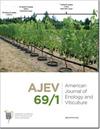甜酒中挥发性有机化合物作为葡萄脱水/枯萎/干燥过程的标志
IF 1.8
3区 农林科学
Q3 BIOTECHNOLOGY & APPLIED MICROBIOLOGY
引用次数: 0
摘要
采用气相色谱-质谱法对来自意大利的24款西番莲甜酒进行了分析。除了未知的酿造过程外,Passito葡萄酒在使用的失水技术、葡萄品种和原产地的纬度/地形方面也有所不同。鉴定了两种挥发性有机化合物标记物,乙酸乙酯和糠醛,表征了用Vin Santo技术生产的葡萄酒、日晒葡萄酒和晚收葡萄酒。在“fruttaio”(封闭设施)中,在受控或非受控条件下,用葡萄脱水生产的葡萄酒中发现了这些化合物的低浓度。马斯喀特品种的葡萄酒含有更多的酯类和萜烯,但在意大利北部的fruttaio脱水葡萄生产的葡萄酒,特别是那些生长在高山上的葡萄酒,比在意大利南部生产或使用阳光干燥的马斯喀特葡萄酒含有更多。报告了每种葡萄酒的主要和次要香气化合物。脱水过程中的受控环境,最好是在低温下,可以更好地保存葡萄的香气,用于葡萄酒生产。本文章由计算机程序翻译,如有差异,请以英文原文为准。
Volatile Organic Compounds in Sweet Passito Wines as Markers of Grape Dehydration/Withering/Drying Process
Twenty-four sweet Passito wines from Italy were analyzed through gas chromatography-mass spectrometry. Apart from the vinification process, which was unknown, the Passito wines differed in the water loss technique used, the grape variety, and the latitude/orography of provenance. Two volatile organic compound markers, ethyl acetate and furfural, were identified, characterizing wines produced with the technique of Vin Santo, wines from sun drying, and wines from late harvest. These compounds were found at low concentrations in wines produced with grapes dehydrated in “fruttaio” (closed facility), under controlled or uncontrolled conditions. Wines from Muscat varieties had more esters and terpenes, but the wines produced from grapes dehydrated in fruttaio in North Italy, particularly those grown on high mountains, had more than Muscat wines produced in South Italy or using sun drying. Primary and secondary aroma compounds are reported for each wine. A controlled environment during dehydration, preferably at low temperature, better preserves the aroma of grapes for wine production.
求助全文
通过发布文献求助,成功后即可免费获取论文全文。
去求助
来源期刊

American Journal of Enology and Viticulture
农林科学-生物工程与应用微生物
CiteScore
3.80
自引率
10.50%
发文量
27
审稿时长
12-24 weeks
期刊介绍:
The American Journal of Enology and Viticulture (AJEV), published quarterly, is an official journal of the American Society for Enology and Viticulture (ASEV) and is the premier journal in the English language dedicated to scientific research on winemaking and grapegrowing. AJEV publishes full-length research papers, literature reviews, research notes, and technical briefs on various aspects of enology and viticulture, including wine chemistry, sensory science, process engineering, wine quality assessments, microbiology, methods development, plant pathogenesis, diseases and pests of grape, rootstock and clonal evaluation, effect of field practices, and grape genetics and breeding. All papers are peer reviewed, and authorship of papers is not limited to members of ASEV. The science editor, along with the viticulture, enology, and associate editors, are drawn from academic and research institutions worldwide and guide the content of the Journal.
 求助内容:
求助内容: 应助结果提醒方式:
应助结果提醒方式:


